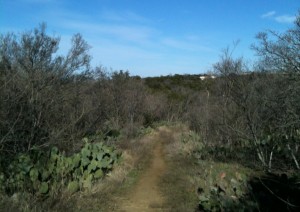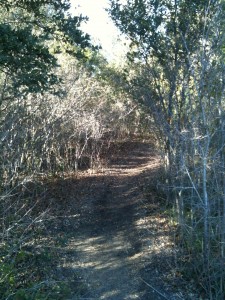“Each year, after the midwinter blizzards (or for Austin, “snow days”), there comes a night of thaw when the tickle of dripping water is heard in the land.” – Aldo Leopold, January, Page 3, A Sand County Almanac)
As I walked through Blunn Creek, having last been here in early winter (November for my ENSP Service Learning Project), I noticed less color and more dead plants. Winter has definitely taken it’s toll. The creek has now become a mere trickle compared to what it was in November. The dead and dying, withering trees have become nothing more than dilapidated, cumbersome dams interrupting the flow of the creek through the preserve. The cacti’s needles have become droopy on the plants and brittle enough to break with your fingers. As I went right at the first fork in the trail, I was greeted by a small jackrabbit, no bigger than a cantaloupe. Since I have been in the preserve, approximately 30 minutes, I have seen over a dozen people (one jogger and an Environmental Science class from Travis High School). When working here last semester, the most present danger that my classmates and I faced was poison ivy. Since walking through the preserve, from the entrance closest to school to the volcanic overlook (taking many different paths along the way), I haven’t seen a single poison ivy leaf, much less an entire plant. That being said, I notice a correlation with invasive species; the Wax Leaf Ligustrum is still present but the number of smaller plants (based on size, circumference of trunk, etc.) such as Chinaberry has seemed to diminish. I am extremely interested to come back in a week or two and see how the preserve looks then.
January 29, 2014
High Temp: 54 Low Temp: 37 Current Temp: 48 // Sunny, partly cloudy




